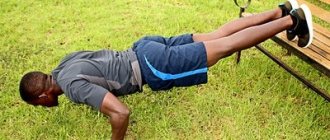Where can pull-ups come in handy?
Pull-ups are a very “vital” exercise. If we need to climb somewhere, but there is no one to help us, pull-ups will help us out. We can hang by our hands and pull up our body. And if you know how to do push-ups from the floor or parallel bars, the task becomes even easier. Comprehensive preparation is important.
Grip strength saves lives in extreme conditions. And not only yours, but also someone else’s. It happens that you need to hold someone or help them up.
Of course, we are not only talking about dangerous situations, but also about everyday activities. When there is not even a hint of a platform at suburban stations, it is quite difficult to help people get into the car. You must offer your hand, holding the railing with your other hand as you exit the carriage. Sound familiar? In such ordinary cases, a strong grip and the ability to pull yourself up significantly facilitate the entire process.
And if you do, for example, mountain climbing, then pull-ups are a vital exercise. This is what will save your life and prevent you from falling down. And the more you pull yourself up, the better.
I hope you are convinced that you need to be able to do pull-ups. Our program will help you learn!
Preparing for your first pull-up
No matter how ridiculous it may sound, some people cannot do a single pull-up. And it's not that they are heavy. It's not that pull-ups are difficult exercises. It’s just that people have never practiced this; their muscles “don’t know” how to contract correctly. This is especially true for representatives of the fair sex.
In general, pull-ups for girls are optional. And if they can't do it, that's okay. If desired, you can achieve 1-2 times on the bar if necessary. Next we will talk about how this can be done.
It is advisable for a man to perform pull-ups at least 10 times at a slow pace without jerking.
Getting used to hanging
Any program must include elements of preparation. First you need to find a good crossbar. It must be at an accessible height. That is, so that you can reach the horizontal bar from a small jump or by rising on your toes.
Let us remind you that during training on the horizontal bar, you can hold on to it with two types of grips - forward and reverse. Straight grip is the usual position of the hands with the palms facing away from you. Reverse - with your palms facing you. You can also place your thumb with the rest and opposite them. The latter option provides a more secure grip.
So, grab the horizontal bar with an overhand grip, placing your hands slightly wider than shoulder-width apart. Hang from the horizontal bar without your feet touching the floor or ground. The first time you can hang for up to 5 seconds, then your hands will unclench. And the more you weigh, the funnier you will slide off the horizontal bar - this is normal. To fully do at least 10 pull-ups, you need to hang on the horizontal bar for at least 40 seconds. This is necessary for beginners who may slip off the bar at the most inconvenient moment.
To increase your hang time simply add 1-2 seconds each time until you reach 60 seconds. Your hands will shake - be patient. All physical achievements come through overcoming oneself.
However, try not to overwork yourself. If you can hang for 1-2 seconds, that's okay. Practice. Hang 3-5 times every day. In a month, you will see that the time you hang on the horizontal bar has noticeably increased. The main thing for beginners is the goal. You need to develop the habit of achieving it.
Shoulder raise on the horizontal bar
The exercise improves grip strength and makes it possible to remember the initial position of the body. You just need to hang on the horizontal bar, palms slightly wider than shoulders, abs tense, gaze directed straight. After this, you need to bring your shoulder blades together and slightly lift your shoulders up, then lower them to their original position. This warms up the shoulder girdle well before starting horizontal bar exercises.
Achieving the first pull-up
Beginners don’t get their first pull-up right away. It seems to have strength, it seems to be not heavy, but it never works out. The muscles “don’t know” what to do and how to contract. This is similar to the ability to tense the desired muscle in isolation. If you explain how to do this, everything will work out pretty quickly. If you cannot pull yourself up due to muscle atrophy, everything is more complicated. But you can always learn.
The first pull-up can be achieved in several ways.
Negative
This is probably not the best method for beginners. You need to place a chair under the horizontal bar so that you can reach the starting position with the help of your legs, or find a low horizontal bar. Next, we gradually relax our legs until the entire load from holding the body in this position is distributed to the arms and back.
From this position you need to lower yourself as slowly as possible, straightening your arms. It is believed that such training will help increase the number of pull-ups. However, we do not recommend it for beginners. Negativity with weight is fraught with tendon strain, and without weights and help on the rise, the results are insignificant. Read more about negative pull-ups in a separate article on the website. Let's look at another method.
Use of shock absorbers
A good way to prepare your body for pull-ups is with regular rubber. It is wrapped around the horizontal bar so that a loop is formed that will serve as a kind of swing. Due to this, it will be easier to go up, as well as to go down. Once your muscles get used to it, you can remove the aids. Now you can do pull-ups on your own, all that remains is to increase the number of repetitions.
Get help from a partner. It often happens that guys help girls with pull-ups - they push them on the rise, and the girl makes the reverse movement on her own. This is a pretty effective way to learn how to do pull-ups (and a fun one, too). Please note, this is the same negative, but with help on the rise.
Use of simulators
If you have the opportunity to go to the gym, you will have every chance to learn how to do pull-ups. There you will be able to perform exercises that will help you do your first time on the horizontal bar.
Pay attention to machines that simulate pull-ups. This is, first of all, the upper block. His row is an imitation of a pull-up with any grip. Start with a weight that you don't find too heavy. Increase it over time. One day, when you reach half your body weight, you will be able to do 5 pull-ups with ease.
Another device for this purpose is a counterweight pull-up machine, or gravitron. Read a detailed analysis in a separate article on the website.
The program for the first pull-up for beginners is simple: try and try again. Until you succeed. Don't forget, proper technique is the key to success. We do everything smoothly, without jerks.
Let's go further: increase the number of pull-ups (table)
When you learn how to do these exercises, you need to take care of the quantity. A special scheme or program will help you.
Various exercises on the horizontal bar will be useful for developing strength and your muscle profile. Please note that it is still too early to work with weights. When you can do more than 15 pull-ups, you can think about additional weights. It is inappropriate to talk about this now.
We recommend doing pull-ups with a classic straight grip shoulder-width apart, a wide grip and a narrow reverse grip. These 3 exercise options will allow you to develop strength quite quickly. Now let's combine them to get the desired program for gaining the number of pull-ups. For ease of perception, this will be a table. Let's say you can do 2-3 pull-ups.
Exercise scheme for beginners to increase the number of pull-ups:
| Type of pull-ups | Number of times | |||||||
| Day 1 | 2 | 3 | 4 | 5 | 6 | 7 | 8 | |
| Classic version | 2 | 3 | 3 | 3 | 4 | 4 | 4 | 5 |
| Wide grip | — | — | — | — | 1 | 1 | 2 | 2 |
| Reverse close grip | 2 | 2 | 3 | 4 | 4 | 5 | 6 | 5 |
You can exercise every day. So in 8 days you can go from 2 to 5 reps. We recommend doing the last exercise to failure as much as you can.
This is an approximate training plan, you can change it. Our task is to orient you so that you understand what principle to act on.
The wide-grip pull-up is the most difficult version of the exercise, since the underdeveloped latissimus dorsi muscles play a big role in it. Therefore, it appears on the fifth day of training in a small number of repetitions.
Types of pull-ups
Training on the horizontal bar has proven to be a universal complex. Correct execution technique guarantees a positive result and no injuries. There is a technique that allows you to learn how to do pull-ups without a horizontal bar. It is used in cases where it is never possible to pull yourself up on the crossbar. Usually the cause is a lack of training of the ligaments, shoulder girdle and arms. You should use exercise equipment to master the technique and weights (dumbbells).
Preparation for pull-ups without a horizontal bar:
- To work the shoulder muscles, to do this you need to pick up dumbbells and perform lateral raises. Knees slightly bent at the knees, body straight, look up. You need to sharply spread your arms, lift the dumbbells to shoulder height. Number of repetitions – 8, approaches – 3.
- Sit on the upper row machine, fixing your knees on the support. Use your hands to pull the handles of the exercise machine towards you, trying to touch your collarbone. While doing this, we strain our back muscles.
- We change to narrow and reverse grips, head pulls. All these exercises affect the muscle frame and ligaments, preparing them for the main pull-ups.
Let's focus on the group of muscles responsible for the technique of working on the horizontal bar. Participating in this work:
- back extensors, teres, trapezius and rhomboid muscles;
- pectoral muscles;
- abdominal muscles;
- biceps, triceps;
- brachialis and forearm muscles.
Types of pull-ups are divided by phases and the presence of weights. The main and defining difference is the method of fastening. Grips differ in distance and grip option.
Types by distance between hands:
- narrow grip – the athlete’s hands are placed less than shoulder width apart;
- medium – the distance between the grips is at shoulder level, or slightly wider;
- wide grip - the distance between the hands is greater than the width of the shoulders.
Differences in grip method:
- overhand or straight grip - palms turned away from the face;
- reverse or lower - palms opposite the face, the hand from below holds onto the crossbar;
- neutral or parallel - palms facing each other.
Depending on the type of grip, the load on muscle groups changes. If you use the classic method at an average distance, the load is approximately the same on all muscles. This is one of the simple ways in which you can learn to do pull-ups on the bar. Exercise on the horizontal bar at a maximum distance (wide grip) increases the load on the back muscles. In the opposite case, the greatest force falls on the biceps. The shoulders experience the most stress in a narrow, straight grip. You need to learn how to do pull-ups on the horizontal bar using weights.
The following types of movements are divided by technique:
- classic;
- kipping;
- butterfly;
- body to crossbar;
- jumping movements.
All of these species are similar, the difference lies in the position of the limbs. In the classic approach, the legs are motionless, in kipping and butterfly you need to swing, due to inertia, the body rhythmically rises above the horizontal bar. Athletes have different opinions about the difficulty of techniques. Many people consider kipping pull-ups to be the best; they are actually easier to perform than the classic ones. There is also a drawback - if done incorrectly, there is a risk of injury or sprain.
Performing pull-ups, if the athlete did not know how to work on the horizontal bar at all, should be done with careful movements with a medium grip. You need to increase the number of approaches gradually. Several pull-ups – 7-9 times – provide an even load on the muscles. If you increase the number of movements, endurance develops. A warm-up - push-ups on the floor or bench - will help you get up from scratch.
The training program will depend on your goal. If you learn how to do 15 classic pull-ups in one approach, then you can begin more complex techniques.
It is not recommended to rush, all movements must be performed clearly, without jerking, and technically correct pull-ups must be obtained. There's no point in working out until you're exhausted. Learn to distribute your strength; it is better to use 70 percent of your strength reserve when training from scratch.
When the plateau comes
One day the number of pull-ups will stop increasing. This will definitely happen. You need to be patient here. The following scheme is designed to overcome the plateau. Let's say you start doing 8-9 pull-ups and can't do any more.
Scheme (table) for increasing the number of repetitions on the horizontal bar in a plateau state:
| Type of pull-ups | Number of times | |||||||
| Day 1 | 2 | 3 | 4 | 5 | 6 | 7 | 8 | |
| Classic version | 8 | 9 | 10 | 11 | 12 | 8 | 10 | 15 |
| Wide grip | 5 | 9 | 10 | 11 | 12 | 12 | 10 | 15 |
| Reverse close grip | 8 | 9 | 10 | 11 | 12 | 12 | 10 | 15 |
Please note that classes must be held every other day.
The nuance of this scheme is this: if you can’t complete all the repetitions in a set, stretch out the pleasure. Your task is to do all the times. Let it be with a break, but do it. For example, on the first day you did 8 pull-ups with a straight grip, but only 3 with a wide grip. Rest, then do 2 more. Thus, you will get the required 5 repetitions.
On day nine, add a second set to each exercise and start from day one. That is, you do 8 classic pull-ups in two approaches, 2 x 5 with a wide grip and 2 x 8 with a narrow grip. Do this for another 8 days and add a third approach. After 24 days, you will be able to do 15–20 pull-ups in one set. The main thing is persistence.
The key rule during a plateau is don’t give up, don’t stop doing exercises. Take breaks, but stick to the plan. There have been cases when young men, having done 1-2 pull-ups, gained 20-30 reps in one workout due to perseverance. This technique allowed them, after a month, to do more complex elements on the horizontal bar (exit by force and others).
Listen to your body to avoid injury. Distinguish between laziness and overtraining. The diagram below will lead you to the result.
How to do pull-ups better
Professionals give advice on choosing the best pull-up option, by listening to which you can master the technique and avoid dangerous consequences.
With full hang
They begin the exercise by relaxing the muscles of the back and shoulders, and after a short pause they pull themselves up. The advantage is an increased range of motion, giving the muscles a better stretch. The disadvantage is the risk of sprained ligaments and tendons.
With tension
This is the best version of pull-ups aimed at strengthening the muscle tissue of the back. Your elbows should be fully extended and your shoulders slightly relaxed. This option is more difficult to complete than it might seem at first. 10 pull-ups become a difficult task even for a physically fit person.
With rocking
Movement of the hips and torso provides momentum for the lift. This method increases endurance, increases the number of repetitions, and strengthens the pectoral and back muscles. The disadvantage is the possibility of damage to the shoulder joints if they are unstable. You should not try to do this exercise on the first day; you need to start with simpler options.
Pull-ups with swinging.
Recommendations for pull-ups
Learn and apply:
- Gradualism. You won't achieve great results if you rush. Other than overtraining and injury, you won't get anything. This applies to burdens and cheating.
- There is a certain pull-up technique - you lift your body as you exhale so that your chin is higher than the bar. Whether you stay there or not is up to you. Slowly lower yourself back down while inhaling.
- All exercises are done smoothly and without jerking. The snatch is not a full pull-up, remember this. In addition, you can damage your muscles.
- Warm up before you start doing pull-ups.
- There is no need to hang for a while with your chin over the bar. This will give you nothing but injury. It’s enough to hang like that for 30 seconds, there’s no point anymore.
- When doing a wide-grip pull-up, your goal is to feel the lats.
- If you cannot do more than 10-15 reps per set, you should not use weights.
- Rest between sets for 1-2 minutes, but you can’t stay in place - walk, wave your arms, chase away mosquitoes.
- To make your hands feel good on the horizontal bar, you can exercise in special gloves.
- Try to choose high horizontal bars so that your bent knees do not interfere with your ability to pull yourself up.










